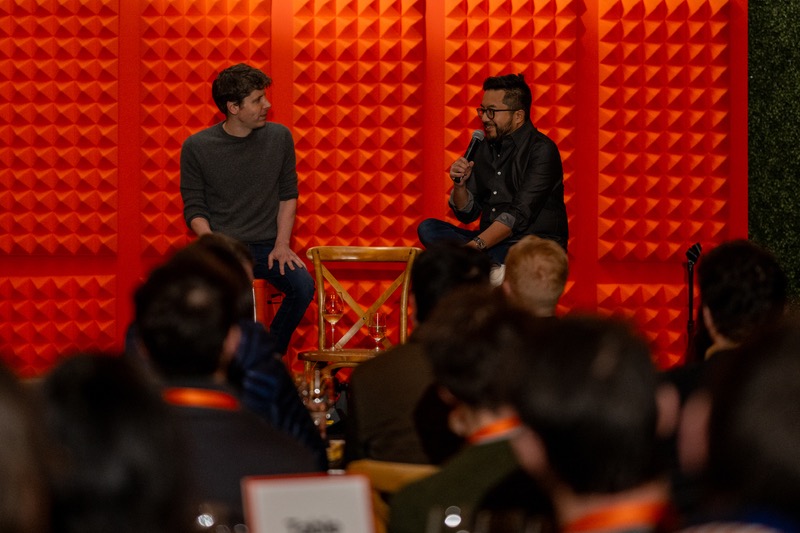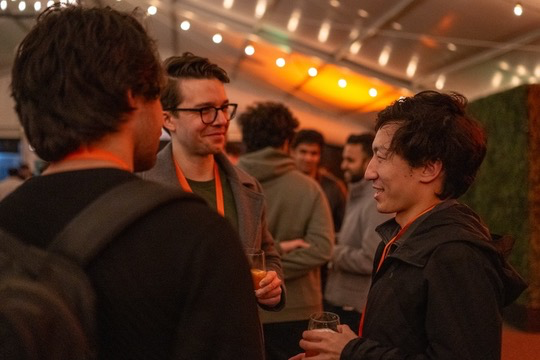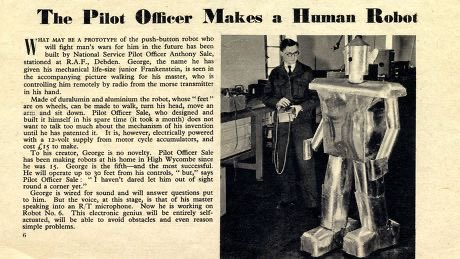Predictions for robotics in 2025, the rest of the decade, and beyond
 Y Combinator AI Retreat with Sam Altman and Garry Tan
Y Combinator AI Retreat with Sam Altman and Garry TanOur co-founders Kaan and Evan were invited to Y Combinator's first-ever AI retreat, where they got to hear from Sam Altman, Jason K. (Chief Strategy Officer at OpenAI), Ron Conway, and other incredible leaders.¹
 Evan Wineland and Kaan Dogrusoz at YC's first-ever AI retreat
Evan Wineland and Kaan Dogrusoz at YC's first-ever AI retreatThey were asked to give a talk, and they brought some predictions for the near-future of robotics.
Here's the text of that talk (along with the original posts).
A bit about today
It's worth taking a second to appreciate the extent to which robots already are here and have been. Here's a fun fact: industrial robots were in use in factories as long ago as 1961, with the Unimate arm.
 The Unimate arm, the first industrial robot from 1961
The Unimate arm, the first industrial robot from 1961The Roomba came out over two decades ago.
 A newspaper clipping from 1949 about "The Pilot Officer Makes a Human Robot"
A newspaper clipping from 1949 about "The Pilot Officer Makes a Human Robot"What's got people excited right now?
Internet-scale data has given LLMs and VLMs meaningful semantic understanding of language and visual input: robots increasingly understand what they see. They can "talk" to you about it. These models also seem increasingly capable of generating longer-horizon plans thanks to what they've seen in their training data. (And video generation models (VGMs) increasingly look like they go a step further: they seem to be able to predict future world states with better and better understandings of physics)
Combining models with semantic world knowledge with policies trained on embodied data has led to impressive capabilities that were once considered out of reach in real-world settings. Laundry folding is one example; see Physical Intelligence's latest laundry folding,³ or what we did with our prototype last summer during our Y Combinator batch.⁴ Generalist "policies" (i.e., models) trained with cross-embodiment robotic data on top of VLM backbones will continue to show promise.
Expect physically accurate simulations and reinforcement learning to continue to be useful for locomotion and manipulation. There's a lot of attention on how reinforcement learning can push generalization for manipulation.
2025
First, what robots will we see? Now's also a time to note like we did to our audience that our focus will more so be on B2C.
On the B2B side, limited-purpose and even general-purpose robots are indeed already here. What's likely to change in 2025 is the number of business announcing partnerships with general-purpose robot manufacturers as the technology continues to mature.
On the B2C side, we already see "extrapolation" in lots of limited purpose robots just since CES:
• Roombas + arms
• Quadrupeds (like Go2) + arms
• Modular robots (Switchbot: air purifier, iPad holder, vacuum)
I expect these to be quick to commercialize, which is the advantage of these form factors.
You'll also see the first serious attempts to bring general-purpose robots into homes.
What will the first general-purpose B2C robots do?
This is the big question! There will almost certainly be a focus on teleoperated tasks first with a focus on gathering data to train models to do those same tasks autonomously, or the robots will start with well-chosen first autonomous tasks. Whatever those tasks are, they'll be contained but useful parts of valuable workflows.
Our take on this at Weave Robotics is Isaac, which will fold laundry, tidy up messes on floors and surfaces, and be your home's caretaker while you're gone. That focus is part of why we're planning to deliver to our first 30 reservation holders this year, followed by the people on our waitlist.
What about after 2025?
Productization will really come into its own over the rest of this decade. Robots will pervade our lives much more (in all sectors). If 2025 is indeed when the first general purpose robots ship to first adopters, 2026 will be the year that demand surges.
Why?
• First, robotic capabilities and reliability will only grow: we expect the "cost-capability-safety" Pareto frontier to keep moving steadily forward every year.
• Second, there's already a tremendous value to the richness of data such systems will have access to (with their owner's permission) once they've demonstrated the right to be in homes and businesses consistently. This will be a huge unlock for users of AI systems; the power of rich context has only been made more and more clear as context lengths grow
• Third, robots with capable VLMs will begin to offer software-like guarantees for the physical world. (Imagine, for instance, an automation for giving your dog food every day)
• Furthermore, from the side of developers of robots or AI systems, not having an embodiment or operating in more and more complex environments will hinder one's ability to have a complete understanding of reality. This is a crucial point, because data flywheels from actual usage, in dynamic environments like the home, will grow in importance relative to data from structured environments.
2030 and beyond (predictions)
With questions, we ran over time and didn't get to this section live!
Here's where anyone trying to speak on the subject should caveat that we're squarely in prediction territory 🚨 There are a lot of intersecting considerations that make timelines hard. Nonetheless, a few things seem likely:
Quickly, on the B2B side, special-purpose robots will continue to have a major role here even as general-purpose robots mature and continue to come online and provide tremendous value. Special-purpose robots have been the only successful robots since humans started building them for a reason
And one quick take: nations will probably wake up soon to the importance of robotic automation for their national competitiveness. This will probably have implications for globalization, broadly. Suffice it to say demographic trends are only the tip of the spear of this realization.
On the consumer side, the 2030s seem likely to be the decade in which everyone comes to have their own "universal basic robot", to use Garry Tan's language! This seems only more likely as timelines shorten for artificial general intelligence in software. We also intend to have a say in the matter at Weave Robotics.
That said, we don't expect that one form factor will rule them all. Consumers will still probably have lots of choices for what kind of robot does tasks for them, depending on what they want along a few dimensions: price, product design (aesthetics, size, volume), competence requirements (at what set of tasks, with what speed)
Closing
The future of robots is bright. I'm particularly excited about consumer robots because they'll save people from dull and mundane tasks and give people more control over their own lives.
To go back to the beginning: soon you won't have to choose between a robot that passes the butter and one that increasingly folds into the greater fabric of your life, knocking out more and more of your biggest time-sucking or unpleasant tasks, repeatedly.
That future is not far away, at all—it's nearly here.
¹ All details and comments made at the conference, and what any speaker said, are off the record and unconnected to our talk.
² https://www.youtube.com/watch?v=X7HmltUWXgs
³ https://www.physicalintelligence.company/blog/pi0
⁴ https://x.com/chris_j_paxton/status/1839689113105990029